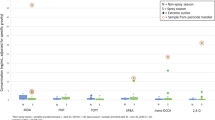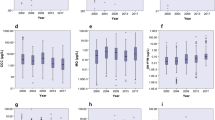Abstract
In pesticide biomonitoring studies, researchers typically collect either single voids or daily (24-h) urine samples. Collection of 24-h urine samples is considered the “gold-standard”, but this method places a high burden on study volunteers, requires greater resources, and may result in misclassification of exposure or underestimation of dose due to noncompliance with urine collection protocols. To evaluate the potential measurement error introduced by single void samples, we present an analysis of exposure and dose for two commonly used pesticides based on single morning void (MV) and 24-h urine collections in farmers and farm children. The agreement between the MV concentration and its corresponding 24-h concentration was analyzed using simple graphical and statistical techniques and risk assessment methodology. A consistent bias towards overprediction of pesticide concentration was found among the MVs, likely in large part due to the pharmacokinetic time course of the analytes in urine. These results suggest that the use of single voids can either over- or under-estimate daily exposure if recent pesticide applications have occurred. This held true for both farmers as well as farm children, who were not directly exposed to the applications. As a result, single void samples influenced the number of children exposed to chlorpyrifos whose daily dose estimates were above levels of toxicologic significance. In populations where fluctuations in pesticide exposure are expected (e.g., farm families), the pharmacokinetics of the pesticide and the timing of exposure events and urine collection must be understood when relying on single voids as a surrogate for longer time-frames of exposure.
This is a preview of subscription content, access via your institution
Access options
Subscribe to this journal
Receive 6 print issues and online access
$259.00 per year
only $43.17 per issue
Buy this article
- Purchase on Springer Link
- Instant access to full article PDF
Prices may be subject to local taxes which are calculated during checkout



Similar content being viewed by others
Notes
Adult reference values were based on adult Caucasian men age 25–44 on self-selected diets. Reference values for children (also Caucasian, on self-selected diets) were age-, sex- and body weight-specific.
References
Adgate J.L., Clayton C.A., Quackenboss J.J., Thomas K.W., Whitmore R.W., and Pellizzari E.D., et al. Measurement of multi-pollutant and multi-pathway exposures in a probability-based sample of children: Practical strategies for effective field studies. J Expo Anal Environ Epidemiol 2000: 10(6 Part 2): 650–661.
Baker B.A., Alexander B.H., Mandel J.S., Acquavella J.F., Honeycutt R., and Chapman P. Farm family exposure study: Methods and recruitment practices for a biomonitoring study of pesticide exposure. J Expo Anal Environ Epidemiol 2005: 15(6): 491–499.
Barr D.B., Wilder L.C., Caudill S.P., Gonzalez A.J., Needham L.L., and Pirkle J.L. Urinary creatinine concentrations in the US population: Implications for urinary biologic monitoring measurements. Environ Health Perspect 2005: 113(2): 192–200.
Bingham S.A., Williams R., Cole T.J., Price C.P., and Cummings J.H. Reference values for analytes of 24-h urine collections known to be complete. Ann Clin Biochem 1988: 25(Part 6): 610–619.
Bland J.M., and Altman D.G. Statistical methods for assessing agreement between two methods of clinical measurement. Lancet 1986: 1(8476): 307–310.
Feldmann R.J., and Maibach H.I. Percutaneous penetration of some pesticides and herbicides in man. Toxicol Appl Pharmacol 1974: 28: 126–132.
Fenske R.A., Kissel J.C., Lu C., Kalman D.A., Simcox N.J., and Allen E.H., et al. Biologically based pesticide dose estimates for children in an agricultural community. Environ Health Perspect 2000: 108(6): 515–520.
Griffin P., Mason H., Heywood K., and Cocker J. Oral and dermal absorption of chlorpyrifos: a human volunteer study. Occup Environ Med 1999: 56: 10–13.
Harris S.A., and Solomon K.R. Percutaneous penetration of 2,4-dichlorophenoxyacetic acid and 2,4-D dimethylamine salt in human volunteers. J Toxicol Environ Health 1992: 36: 233–240.
Hinwood A.L., Sim M.R., de Klerk N., Drummer O., Gerostamoulos J., and Bastone E.B. Are 24-h urine samples and creatinine adjustment required for analysis of inorganic arsenic in urine in population studies? Environ Res 2002: 88(3): 219–224.
Kissel J.C., Curl C.L., Kedan G., Lu C., Griffith W., and Barr D.B., et al. Comparison of organophosphorus pesticide metabolite levels in single and multiple daily urine samples collected from preschool children in Washington state. J Expo Anal Environ Epidemiol 2005: 15(2): 164–171.
Kohli J.D., Khanna R.N., Gupta B.N., Dhar M.M., Tandon J.S., and Sircar K.P. Absorption and excretion of 2,4-dichlorophenoxyacetic acid in man. Xenobiotica 1974: 4: 97–100.
MacIntosh D.L., Needham L.L., Hammerstrom K.A., and Ryan P.B. A longitudinal investigation of selected pesticide metabolites in urine. J Expo Anal Environ Epidemiol 1999: 9(5): 494–501.
MacIntosh D.L., Kabiru C., Echols S.L., and Ryan P.B. Dietary exposure to chlorpyrifos and levels of 2,5,6-trichloro-2-pyridonol in urine. J Expo Anal Environ Epidemiol 2001: 11: 279–285.
Meeker J.D., Barr D.B., Ryan L., Herrick R.F., Bennett D.H., and Bravo R., et al. Temporal variability of urinary levels of nonpersistent insecticides in adult men. J Expo Anal Environ Epidemiol 2005: 15(3): 271–281.
Morgan M.K., Sheldon L.S., Croghan C.W., Jones P.A., Robertson G.L., Chuang J.C., WIlson N.K., and Lyu C.W. Exposures of preschool children to chlorpyrifos and its degradation product 3,5,6-trichloro-2-pyridonol in their everyday environments. J Expo Anal Environ Epidemiol 2005: 15: 297–309.
Mueller E., Latini J., Lux M., Stablein U., Brubaker L., and Kreder K., et al. Gender differences in 24-h urinary diaries of asymptomatic North American adults. J Urol 2005: 173(2): 490–492.
Nolan R.J., Rick D.L., Freshour N.L., and Saunders J.H. Chlorpyrifos: Pharmacokinetics in human volunteers. Toxicol Appl Pharmacol 1984: 73(1): 8–15.
O'Rourke M.K., Lizardi P.S., Rogan S.P., Freeman N.C., Aguirre A., and Saint C.G. Pesticide exposure and creatinine variation among young children. J Expo Anal Environ Epidemiol 2000: 10(6 Part 2): 672–681.
Remer T., Neubert A., and Maser-Gluth C. Anthropometry-based reference values for 24-h urinary creatinine excretion during growth and their use in endocrine and nutritional research. Am J Clin Nutr 2002: 75(3): 561–569.
Rigas M.L., Okino M.S., and Quackenboss J.J. Use of a pharmacokinetic model to assess chlorpyrifos exposure and dose in children, based on urinary biomarker measurements. Toxicol Sci 2001: 61(2): 374–381.
Sauerhoff M.W., Braun W.H., Blau G.E., and Gehring P.J. The fate of 2,4-dichlorophenoxyacetic acid (2,4-D) following oral administration to man. Toxicology 1977: 8(1): 3–11.
Sunderman F.W., and Boerner F. Normal Values in Clinical Medicine. Saunders: Philadelphia, 1949.
US Environmental Protection Agency, Office of Pesticide Programs. Report on FQPA Tolerance Reassessment Progress and Risk Management Decision for Chlorpyrifos-methyl. Document ID EPA-R-01-003. January 2001 Available: http://www.epa.gov/oppsrrd1/REDs/cpm_tred.pdf.
US Environmental Protection Agency, Office of Pesticide Programs. Interim Reregistration Eligibility Decision for Chlorpyrifos. Document ID: 738-R-01-007. February 2002 Available: http://www.epa.gov/oppsrrd1/REDs/chlorpyrifos_ired.pdf.
US Environmental Protection Agency, Office of Pesticide Programs. Reregistration Eligibility Decision for 2,4-D. Document ID 738-R-05-002. June 2005 Available: http://www.epa.gov/oppsrrd1/REDs/24d_red.pdf.
Wilson N.K., Chuang J.C., Lyu C., Menton R., and Morgan M.K. Aggregate exposure of nine preschool children to persistent organic pollutants at day care and at home. J Expo Anal Environ Epidemiol 2003: 12: 187–202.
Acknowledgements
This publication was made possible by Grant number 5 T32 ES01095 from the National Institute of Environmental Health Sciences (NIEHS), NIH. The contents are solely the responsibility of the authors and do not necessarily represent the official views of the NIEHS, NIH. Data for this study was from the Farm Family Exposure Study which was funded through a grant to the University of Minnesota by Bayer, Dow, Dupont, FMC, Monsanto, Syngenta, and the American Chemistry Council.
Author information
Authors and Affiliations
Corresponding author
Additional information
Disclaimer
Michael J. Bartels and Kathy A Bzak are employees of The Dow Chemical Company, manufacturer of the two chemicals analyzed in this study, 2,4-D and chlorpyrifos, and contributor to the funding of the Farm Family Exposure Study, which was the basis for this research.
Rights and permissions
About this article
Cite this article
Scher, D., Alexander, B., Adgate, J. et al. Agreement of pesticide biomarkers between morning void and 24-h urine samples from farmers and their children. J Expo Sci Environ Epidemiol 17, 350–357 (2007). https://doi.org/10.1038/sj.jes.7500505
Received:
Accepted:
Published:
Issue Date:
DOI: https://doi.org/10.1038/sj.jes.7500505
Keywords
This article is cited by
-
Exposure to Endocrine Disrupting Chemicals in the Dutch general population is associated with adiposity-related traits
Scientific Reports (2020)
-
Variability and exposure classification of urinary levels of non-essential metals aluminum, antimony, barium, thallium, tungsten and uranium in healthy adult men
Journal of Exposure Science & Environmental Epidemiology (2019)
-
Methodological issues in human studies of endocrine disrupting chemicals
Reviews in Endocrine and Metabolic Disorders (2015)
-
Interpreting variability in population biomonitoring data: Role of elimination kinetics
Journal of Exposure Science & Environmental Epidemiology (2012)
-
Population variability of phthalate metabolites and bisphenol A concentrations in spot urine samples versus 24- or 48-h collections
Journal of Exposure Science & Environmental Epidemiology (2012)



